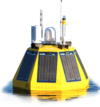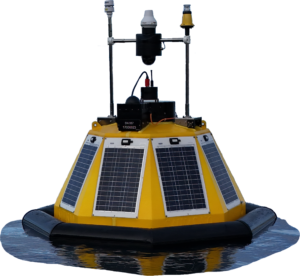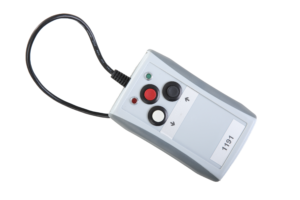Features
Robustness and Field Readiness
- No biofouling on sensors – OWAS principle
- 32 GB internal memory storage
System Overview and Core Functions
- Automatic profiling – Ocean Data Acquisition System (AP-ODAS)
- Remote control for waking, stopping APB5, and winch steering
- Two-way communication with the system
- Real-time data accessible via HTTP on multiple platforms
- Multi-parameter profiling data stored as files and sent via FTP to remote server
- Supported network protocols: FTP, SMS, NTP, WiFi, HTTP
Profiling and Measurement
- CTD profiler with integrated multi-parameter sensors
- CTD unit with built-in 868 MHz radio for data transfer and calibration when docked
- Ultra-low power CTD: up to 250,000 measurements per battery – approx. 50 per profile = 5,000 profiles
- CTD unit runs on primary batteries
- Standard profiling depth: 75 m; extended options: 100m, 150m, 190m
- Programmable profiling speed, depth, and intermediate stops
- Configurable profiling intervals with flexible scheduling options
- Profiling line: Dyneema White, 950 kg breaking strength, Ø3 mm, pre-stretched
Power and Energy Management
- The buoy system harvests solar energy (spring–fall) for winch, comms, and control
- 2.5 kWh LiFePO4 lithium battery pack – expandable to 3.75 kWh
- 200 W solar panel array
- Power consumption (75 m profile): 0.3 mA idle between profiles, 1 A average during vertical CTD profiling
Communication and Connectivity
- Communication via LTE (4G)/5G, Satellite(Iridium Certus 100/200 and WIFI
Optional Modules and Extensions
- Optional weather station
- Optional current speed/direction from ADCP (Nortek Z-cell / Aanderaa)
- Optional wave sensor: Aanderaa Motus
- Optional boxes for external devices (e.g. camera, RPi) with power and WiFi
The Automatic CTD profiling system or Ocean data acquisition system(ODAS), APB5 (Automatic Profiling Buoy ver. 5) is designed for monitoring water quality parameters in coastal waters, fjords, lakes, and aquaculture installations. It consists of a self-contained, solar panel driven, remotely operated, floating buoy and a CTD (Conductivity, salinity, temperature, and depth/pressure) winch-controlled profiling probe. The standard SAIV AS CTD204/208 profiling probe can be upgraded with oxygen, fluorescence, turbidity etc. The APB5 operation system, is web-based and can be remotely configured to set profile intervals, depth, and speed of profile. The APB5 buoy can also be equipped with a Weather Station (GPS, wind speed, wind direction, air temperature) and a ADCP (Acoustic Doppler Current Profiler). The standard profiling depth is 75 meters, but can be extended to 190 meters. The resolution of the profile is based on the configuration of the chosen measuring intervals and the speed of the winch.
The unique OWAS (Out of Water Antifouling System) feature prevents bacterial and algae growth on the probe and its sensitive monitoring sensors, which minimize cleaning maintenance for extended periods of operation. The unit can easily operate autonomously for a full year in between service procedures.
The APB5 buoy contains a control unit (CU801B) with embedded webserver, a 4G WIFI router (GSM/GPRS/EDGE/LTE), a winch, a short-range radio for data transfer and communication with the CTD probe, solar cells, and a battery pack. A satellite router (IMARSAT Fleetbroadband 150) can be added for use in locations without mobile coverage. In case a satellite connection is required the APB5 can be upgraded to the APB5-HD (Heavy Duty) version.
Wireless communication with the CTD probe.
The new CTD profilers from SAIV AS model SD208 and SD204 has an inbuilt low-power, short-range radio, operating at the frequency 868Mhz. This enables wireless data communication between the instrument and the control unit since the profiling CTD Multi parameter probe is suspended inside the buoy and out of water between profiles. It also assures that in between profiles the CTD probe is constantly calibrated with the ambient air pressure and oxygen concentration. In addition, the unique wireless communication system also makes cable connections to the probe redundant, which significantly reduces weight, power demand, and troublesome slip-ring connections in the winch. The profiling probe is simply hanging from the winch by a strong light nylon rope. All this ensures that power consumptions are very low. For example, the CTD profiling probe can operate continuously for 1 year, doing 40 m depth profiles every 2 hours, with a winch speed of 6 seconds per meter, and a measuring interval of 10 seconds.
Link to the Data acquisition pages:
Station.saivas.net This is the default server that is free of charge for all APB5 system: The page shows real time data from an APB5 unit in operation. The page also has a FTP (File Transfer protocol) which enables access to all profile files that is sent from a running APB5 system. Users can make their own presentation on various platforms. It also contains (graphs, videos, article, software and data sheets)
Links to a system made by a user:
ektedata.no is a school education system, for teaching students about environmental measurements and learn how to do analyses of the data. It is a collaboration between the University of Bergen (NORWAY) and a nearby college, and the project is called "Ekte data" translated (Realdata)
Specifications
Embedded Web Server CU801B
LTE(4G)/WIFI router, or satellite router (Iridium Certus 100/200)
Winch control unit and motor
2 * 14.4 Volt (2.5 Kwh) lithium battery pack
Solar Cells: 200 Watt
Free server space and configuration at : station.saivas.net (or custom)
Configurable via internal Webpage and Remote
Programmable Profiling interval, depth etc.
Profiling Depth Range: Standard 75 m /Extended 100, 150 and 190m
868 MHz Radio controllers for instrument communication
Transparent communication to all devices in the buoy and sensor unit for diagnostic purpose etc.
User to provide SIM card.
Data is presented instantaneously on Internet after a ended vertical profile
Optional Weather station: type Airmar 200 wx
Optional ADCP (Acoustic doppler current profiler) : type Nortek
Mooring points: 6 shackle points at lower buoy section,
Anchoring: 2-3-4 anchors (depending on conditions)
Weight of complete buoy in air 250 kg. When in water it will add 300 kg of water as ballast.



